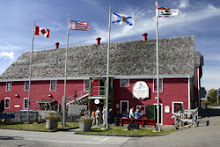
Hello Everyone,
2008 is a special year at the Museum. The last of Canada’s saltbank schooners, Theresa E. Connor, is 70 years old this year!
The Museum had its start aboard the schooner, in 1967; since then we’ve grown to occupy a set of buildings that once housed a huge fish processing plant, a carpenter shop, boat building shop and an ice house. Theresa E. Connor is now joined at wharf side by the trawler Cape Sable, giving a well-rounded view of fishing on the banks of the North Atlantic.
One of the great things about the history of the fishery, on the Atlantic coast of Canada, is that it led to a migration of fishermen and their families. Many Nova Scotians went to the Eastern Seaboard of the United States, establishing a strong link between those left at home with their cousins in the "Boston States". Many fishing families from Newfoundland came to Nova Scotia; their vim and vigour injected a strong burst of energy in the workforce of places like Lunenburg.
We’d love to connect with families who have roots connected to Lunenburg, Nova Scotia. Do you have a connection to our schooner, Theresa E. Connor? The vessel fished from early 1939 until the 1960s.
A saltbank schooner is one that preserved its’ catch by salting it, rather than keeping it on ice. The method of preserving fish in salt is one that dates back thousands of years. When technology developed to the point that there was a steady supply of ice available for the fishing fleets of the North Atlantic, "salt" fishing gave way to "fresh" fishing ~ fish were kept fresh, on ice, and the vessels returned home within weeks, rather than months.
Wishing you smooth sailing,
Heather
Heather

No comments:
Post a Comment